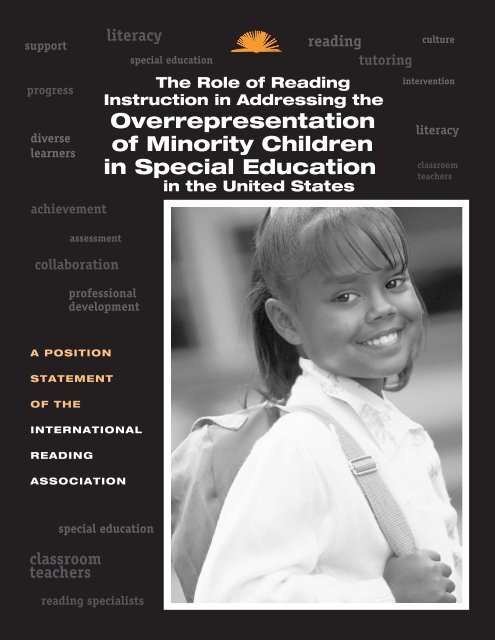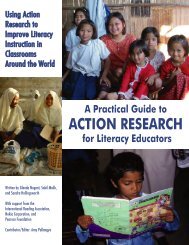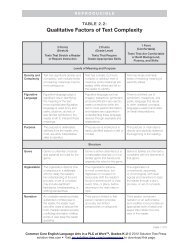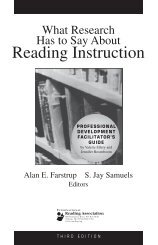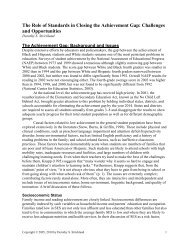Overrepresentation of Minority Children in Special Education
Overrepresentation of Minority Children in Special Education
Overrepresentation of Minority Children in Special Education
You also want an ePaper? Increase the reach of your titles
YUMPU automatically turns print PDFs into web optimized ePapers that Google loves.
support<br />
progress<br />
diverse<br />
learners<br />
achievement<br />
assessment<br />
collaboration<br />
literacy<br />
special education<br />
read<strong>in</strong>g<br />
tutor<strong>in</strong>g<br />
The Role <strong>of</strong> Read<strong>in</strong>g<br />
Instruction <strong>in</strong> Address<strong>in</strong>g the<br />
<strong>Overrepresentation</strong><br />
<strong>of</strong> <strong>M<strong>in</strong>ority</strong> <strong>Children</strong><br />
<strong>in</strong> <strong>Special</strong> <strong>Education</strong><br />
<strong>in</strong> the United States<br />
pr<strong>of</strong>essional<br />
development<br />
culture<br />
<strong>in</strong>tervention<br />
literacy<br />
classroom<br />
teachers<br />
A POSITION<br />
STATEMENT<br />
OF THE<br />
INTERNATIONAL<br />
READING<br />
ASSOCIATION<br />
special education<br />
classroom<br />
teachers<br />
read<strong>in</strong>g specialists
A<br />
strong collaborative relationship among classroom teachers, school-district<br />
curriculum leaders, Title I literacy specialists, and special education teachers<br />
is essential for reduc<strong>in</strong>g the read<strong>in</strong>g achievement gap <strong>in</strong> the United States<br />
between African American, Hispanic, and Native American students and their white<br />
and Asian/Pacific Islander counterparts. The International Read<strong>in</strong>g Association is<br />
particularly concerned that lack <strong>of</strong> appropriate read<strong>in</strong>g <strong>in</strong>struction and early read<strong>in</strong>g<br />
<strong>in</strong>terventions among low-perform<strong>in</strong>g m<strong>in</strong>ority children is contribut<strong>in</strong>g to the<br />
overrepresentation <strong>of</strong> these children <strong>in</strong> the high-<strong>in</strong>cidence disability categories <strong>of</strong><br />
mental retardation (MR), emotional disturbance (ED), and specific learn<strong>in</strong>g disability<br />
(SLD). Once they are identified and placed <strong>in</strong> these categories, children may not<br />
have access to a comprehensive curriculum that <strong>in</strong>cludes read<strong>in</strong>g <strong>in</strong>struction that is<br />
responsive to their <strong>in</strong>dividual differences.<br />
Although the problem <strong>of</strong> overrepresentation <strong>of</strong> m<strong>in</strong>ority children <strong>in</strong> U.S. special<br />
education programs is complex and requires actions taken on many fronts, the<br />
Association can contribute to the solution by advocat<strong>in</strong>g for effective early read<strong>in</strong>g<br />
<strong>in</strong>struction for all children and collaborative and susta<strong>in</strong>ed <strong>in</strong>terventions <strong>in</strong> read<strong>in</strong>g<br />
before children are referred to special education.<br />
How do early read<strong>in</strong>g<br />
difficulties affect special<br />
education referral and<br />
placement outcomes?<br />
A large body <strong>of</strong> descriptive and correlational work<br />
suggests that read<strong>in</strong>g difficulty may be a factor <strong>in</strong><br />
special education referral and placement decisions.<br />
Data <strong>in</strong>dicate, for example, that 80% <strong>of</strong> the children<br />
referred for an SLD are referred because <strong>of</strong> read<strong>in</strong>g<br />
problems (Snow, Burns, & Griff<strong>in</strong>, 1998). This is a<br />
substantial number <strong>of</strong> children because SLDs account<br />
for approximately 50% <strong>of</strong> the children placed<br />
<strong>in</strong> special education (U.S. Department <strong>of</strong> <strong>Education</strong>,<br />
2001). Although there are no direct data l<strong>in</strong>k<strong>in</strong>g<br />
read<strong>in</strong>g difficulties to the MR and ED categories,<br />
there is a plausible cha<strong>in</strong> <strong>of</strong> logic suggest<strong>in</strong>g that<br />
early read<strong>in</strong>g difficulty is a factor <strong>in</strong> special education<br />
referrals. Read<strong>in</strong>g difficulty may trigger concerns<br />
about learn<strong>in</strong>g that result <strong>in</strong> MR placements.<br />
The logic cha<strong>in</strong> for ED placements is even stronger:<br />
Early read<strong>in</strong>g difficulty leads to failure, and failure is<br />
<strong>of</strong>ten a contribut<strong>in</strong>g factor <strong>in</strong> misbehavior that may<br />
lead to ED referrals (Losen & Orfield, 2002).<br />
What evidence do we have <strong>of</strong><br />
overrepresentation <strong>of</strong> m<strong>in</strong>ority<br />
students <strong>in</strong> special education<br />
programs?<br />
The issue <strong>of</strong> overrepresentation <strong>of</strong> m<strong>in</strong>ority<br />
students <strong>in</strong> special education programs,<br />
particularly with<strong>in</strong> some regions and states <strong>in</strong> the<br />
United States, is a concern <strong>of</strong> special education<br />
researchers (Artiles & Trent, 1994; Artiles, Trent,<br />
& Palmer, <strong>in</strong> press; Donovan & Cross, 2002; Losen<br />
& Orfield, 2002; Zhang & Katsiyannis, 2002) and<br />
the object <strong>of</strong> study by policy groups such as the<br />
Office <strong>of</strong> Civil Rights and the National Center for<br />
<strong>Education</strong> Statistics.<br />
There is evidence that higher proportions <strong>of</strong><br />
Native American, African American, and Hispanic<br />
students are identified as hav<strong>in</strong>g the high-<strong>in</strong>cidence<br />
disabilities when compared with the proportions<br />
<strong>of</strong> white students identified (Parrish, 2002). For<br />
example, African American students are 2.88 times<br />
as likely as white students to be identified and<br />
placed <strong>in</strong> MR programs, 1.92 times as likely to be<br />
identified and placed <strong>in</strong> ED programs, and 1.32<br />
times as likely to be identified and placed <strong>in</strong> SLD<br />
programs (Parrish, 2002). These odds ratios are<br />
statistically significant for all three high-<strong>in</strong>cidence<br />
disability categories.<br />
What is the extent <strong>of</strong> the<br />
read<strong>in</strong>g achievement gap<br />
and its relationship to overrepresentation<br />
<strong>of</strong> m<strong>in</strong>ority<br />
children <strong>in</strong> special education<br />
programs?<br />
National Association <strong>of</strong> <strong>Education</strong>al Progress data<br />
over the past 30 years document a somewhat<br />
fluctuat<strong>in</strong>g but persistent read<strong>in</strong>g achievement<br />
gap between white students and African<br />
American, Hispanic, and Native American students.<br />
For example, the average read<strong>in</strong>g scores<br />
<strong>of</strong> white students are higher than those <strong>of</strong> black<br />
students at ages 9, 13, and 17 (Donahue, Voekl,<br />
Campbell, & Mazzeo, 1999). As the Figure (see<br />
next page) <strong>in</strong>dicates, the gaps decreased between<br />
the early 1970s and the late 1980s. S<strong>in</strong>ce then,<br />
the gaps have rema<strong>in</strong>ed relatively stable or have<br />
<strong>in</strong>creased.<br />
Recent studies conducted by the National<br />
Center for <strong>Education</strong> Statistics (2002) document<br />
large gaps <strong>in</strong> student achievement on school<br />
tests as early as k<strong>in</strong>dergarten. For example, 73%<br />
<strong>of</strong> white k<strong>in</strong>dergartners were pr<strong>of</strong>icient <strong>in</strong> letter<br />
recognition, but only 59% <strong>of</strong> African American and<br />
49% <strong>of</strong> Hispanic k<strong>in</strong>dergartners were pr<strong>of</strong>icient.<br />
There were similar differences among races<br />
for recognition <strong>of</strong> words’ beg<strong>in</strong>n<strong>in</strong>g and end<strong>in</strong>g<br />
sounds and for pr<strong>in</strong>t familiarity—skills typically<br />
identified as important for success <strong>in</strong> school<br />
(NCES, 2002). Diverse learners are more likely to<br />
be referred for additional test<strong>in</strong>g and placement <strong>in</strong><br />
special education programs because achievement<br />
tests typically do not assess literacy skills that<br />
they may have acquired outside school, and these<br />
skills <strong>of</strong>ten differ from the ones these children<br />
are expected to have when they enter school. If,<br />
<strong>in</strong>deed, the issue is read<strong>in</strong>g, the more appropriate<br />
educational response is to match children’s<br />
<strong>in</strong>dividual learn<strong>in</strong>g capabilities and needs with<br />
the most appropriate read<strong>in</strong>g <strong>in</strong>struction with<strong>in</strong><br />
the least restrictive environment, such as the<br />
children’s classrooms.<br />
Contribut<strong>in</strong>g to the Read<strong>in</strong>g<br />
Achievement Gap<br />
Ineffective <strong>in</strong>struction<br />
The first issue that must be addressed if we are to<br />
solve the overrepresentation <strong>of</strong> m<strong>in</strong>ority students<br />
<strong>in</strong> special education is the quality <strong>of</strong> classroom<br />
<strong>in</strong>struction. Are the referred children “fail<strong>in</strong>g,” or<br />
are the classrooms fail<strong>in</strong>g the children? That the<br />
overrepresentation <strong>of</strong> m<strong>in</strong>ority children <strong>in</strong> special<br />
education tends to <strong>in</strong>crease as both poverty and<br />
the proportion <strong>of</strong> m<strong>in</strong>ority children present <strong>in</strong> the<br />
population <strong>in</strong>crease (Oswald, Cout<strong>in</strong>ho, Best, &<br />
S<strong>in</strong>gh, 1999) suggests that poor <strong>in</strong>struction (i.e.,<br />
classroom <strong>in</strong>struction that is not guided by systematic<br />
assessment or adapted to meet <strong>in</strong>dividual<br />
differences) is a plausible explanation for children’s<br />
low achievement. For example, general achievement<br />
for students <strong>in</strong> high-poverty, predom<strong>in</strong>antly<br />
nonwhite schools is comparatively low. The quality<br />
<strong>of</strong> the teach<strong>in</strong>g force assigned to high-poverty<br />
schools (for example, hav<strong>in</strong>g high numbers <strong>of</strong><br />
<strong>in</strong>experienced and noncertified teachers and us<strong>in</strong>g<br />
parapr<strong>of</strong>essionals), the relatively limited availability<br />
<strong>of</strong> read<strong>in</strong>g material and other resources, and the<br />
physical condition <strong>of</strong> schools are factors significantly<br />
worse <strong>in</strong> high-poverty, predom<strong>in</strong>antly nonwhite<br />
schools. Thus, the lack <strong>of</strong> high-quality <strong>in</strong>struction<br />
<strong>in</strong> read<strong>in</strong>g comb<strong>in</strong>ed with these other factors may<br />
be responsible for the read<strong>in</strong>g failure that prompts<br />
the referral <strong>of</strong> so many m<strong>in</strong>ority children to special<br />
education programs.<br />
Another issue is the belief held by some<br />
teachers that poverty creates deficits <strong>in</strong> children’s<br />
function<strong>in</strong>g and preorda<strong>in</strong>s them to read<strong>in</strong>g<br />
failure. There are, <strong>of</strong> course, strong correlations<br />
among poverty, m<strong>in</strong>ority status, and achievement.<br />
However, poverty itself does not necessarily result<br />
<strong>in</strong> low learn<strong>in</strong>g potential or read<strong>in</strong>g failure, as witnessed<br />
by a significant proportion <strong>of</strong> children and<br />
schools who “beat the odds” (Taylor, Pearson,
Scale score difference<br />
60<br />
FIGURE<br />
Read<strong>in</strong>g achievement gap: Difference <strong>in</strong> average read<strong>in</strong>g scale scores<br />
<strong>of</strong> 9-, 13-, and 17-year-old white and black students: 1971–1999<br />
50<br />
40<br />
30<br />
Age 17<br />
Age 13<br />
Age 9<br />
20<br />
10<br />
0<br />
1971 1975 1980 1984 1988 1990 1992 1994 1996 1999<br />
Year<br />
Note. The gap is determ<strong>in</strong>ed by subtract<strong>in</strong>g the average black score from the average white score at each grade for each year assessed.<br />
Source: U.S. Department <strong>of</strong> <strong>Education</strong>, NCES. (2000). NAEP 1999 Trends <strong>in</strong> Academic Progress: Three Decades <strong>of</strong> Student Performance (NCES<br />
2000-469) and National Assessment <strong>of</strong> <strong>Education</strong>al Progress (NAEP), 1999 Long-Term Trend Assessment, unpublished data produced by the<br />
<strong>Education</strong>al Test<strong>in</strong>g Service.<br />
Clark, & Walpole, 1999). Although we do not wish<br />
to m<strong>in</strong>imize the potential consequences <strong>of</strong> poverty<br />
for children’s learn<strong>in</strong>g, an alternative explanation<br />
is that teachers <strong>in</strong> these environments are unfamiliar<br />
with children’s home cultures, background<br />
experiences, and/or language differences, and<br />
thus they make judgments about children’s<br />
competence us<strong>in</strong>g <strong>in</strong>appropriate criteria. It is the<br />
Association’s position that judgments about all<br />
children’s literacy competence be made after<br />
children have had the opportunity to participate <strong>in</strong><br />
a high-quality classroom read<strong>in</strong>g program.<br />
Uncoord<strong>in</strong>ated services<br />
Another major factor contribut<strong>in</strong>g to low read<strong>in</strong>g<br />
achievement is the lack <strong>of</strong> coord<strong>in</strong>ation among the<br />
regular education, Title I, and special education<br />
programs and teachers (All<strong>in</strong>gton & Walmsley,<br />
1995). At present, services for read<strong>in</strong>g are<br />
fragmented and the <strong>in</strong>ability <strong>of</strong> the school systems<br />
to function efficiently contributes to the existence<br />
<strong>of</strong> read<strong>in</strong>g achievement gaps between poor and<br />
affluent, and m<strong>in</strong>ority and majority children. In 33<br />
U.S. states, the special education fund<strong>in</strong>g system<br />
pays schools on a per-labeled child basis (Greene<br />
& Forster, 2002). There are restrictions on serv<strong>in</strong>g<br />
those children with funds from other sources, and<br />
many special education children cannot receive<br />
services from read<strong>in</strong>g specialists funded through<br />
Title I or other read<strong>in</strong>g-specific state and local<br />
read<strong>in</strong>g programs. Often, the pr<strong>of</strong>essionals who<br />
teach children with high-<strong>in</strong>cidence disabilities<br />
do not have as much expertise and education <strong>in</strong><br />
teach<strong>in</strong>g read<strong>in</strong>g as read<strong>in</strong>g specialists teach<strong>in</strong>g<br />
<strong>in</strong> the same build<strong>in</strong>gs. It is the Association’s<br />
position that the pr<strong>of</strong>essional best qualified to<br />
deliver read<strong>in</strong>g <strong>in</strong>struction be determ<strong>in</strong>ed at the<br />
local level.<br />
A revision <strong>of</strong> special education identification<br />
procedures that <strong>in</strong>volves strong collaboration<br />
among regular educators, read<strong>in</strong>g specialists, and<br />
special educators is essential. Because the reason<br />
for many children’s referrals to special education<br />
is read<strong>in</strong>g difficulty, all pr<strong>of</strong>essionals who<br />
provide read<strong>in</strong>g <strong>in</strong>struction must work together to<br />
ensure both <strong>in</strong>dividualized and sound goals that<br />
are determ<strong>in</strong>ed through systematic and cont<strong>in</strong>uous<br />
evaluation <strong>of</strong> students’ literacy capabilities.<br />
Schools must have the flexibility to determ<strong>in</strong>e<br />
which pr<strong>of</strong>essionals serve which children.<br />
Fund<strong>in</strong>g sources and program regulations must<br />
not constra<strong>in</strong> these important decisions. It is the<br />
Association’s position that placement <strong>in</strong> the high<strong>in</strong>cidence<br />
disability categories should occur only<br />
after classroom teachers, school- or district-based<br />
read<strong>in</strong>g pr<strong>of</strong>essionals, and special educators have<br />
collaborated to implement and susta<strong>in</strong> moderate,<br />
classroom-based <strong>in</strong>terventions.<br />
Start<strong>in</strong>g out beh<strong>in</strong>d<br />
As noted earlier, data <strong>in</strong>dicate that an achievement<br />
gap is present when children arrive at<br />
k<strong>in</strong>dergarten. However, <strong>in</strong> traditional assessments,<br />
language and literacy skills—such as storytell<strong>in</strong>g<br />
and dual-language development—that would<br />
highlight culturally relevant strengths <strong>of</strong> m<strong>in</strong>ority<br />
children are <strong>of</strong>ten overlooked (Garcia, 2000; Nieto,<br />
1997). Many children from poor and m<strong>in</strong>ority<br />
families have not had the same exposure to the<br />
school-valued language and literacy skills that<br />
white and higher socioeconomic status children<br />
have had. The experiences that poor and m<strong>in</strong>ority<br />
children have had <strong>of</strong>ten are unrecognized <strong>in</strong> school<br />
environments. What teachers <strong>of</strong>ten read as lack<br />
<strong>of</strong> achievement are the different forms <strong>of</strong> diverse<br />
learners’ preliteracy experiences (Donovan &<br />
Cross, 2002; Neuman & Celano, 2001).<br />
A Call for Collaboration<br />
Strong collaboration for the delivery <strong>of</strong> education<br />
services <strong>in</strong>volves all the various education pr<strong>of</strong>essionals<br />
serv<strong>in</strong>g a school build<strong>in</strong>g or district. In a<br />
collaborative approach, a child is <strong>in</strong>itially identified<br />
because <strong>of</strong> low achievement. Once he or she has<br />
been identified, the first determ<strong>in</strong>ation is whether<br />
the student’s low achievement represents a<br />
failure to respond to adequate classroom <strong>in</strong>struction<br />
or results from the classroom <strong>in</strong>struction itself<br />
be<strong>in</strong>g <strong>in</strong>adequate. If the classroom <strong>in</strong>struction<br />
currently provided is <strong>in</strong>adequate (i.e., many <strong>of</strong><br />
the children are mak<strong>in</strong>g little progress), the first<br />
task, before or alongside any <strong>in</strong>tervention with the<br />
child, is to improve classroom <strong>in</strong>struction.<br />
If the classroom <strong>in</strong>struction is adequate (i.e.,<br />
many children are mak<strong>in</strong>g satisfactory progress),<br />
the first level <strong>of</strong> <strong>in</strong>tervention is to determ<strong>in</strong>e<br />
whether the child’s achievement improves with<br />
modest <strong>in</strong>structional changes implemented at the<br />
classroom level. The classroom teachers, read<strong>in</strong>g
specialists, and special education pr<strong>of</strong>essionals<br />
collaborate <strong>in</strong> plann<strong>in</strong>g and implement<strong>in</strong>g the<br />
<strong>in</strong>tervention. If the modest <strong>in</strong>tervention does not<br />
elevate the student’s achievement level, then a<br />
second, more <strong>in</strong>tensive level <strong>of</strong> <strong>in</strong>tervention with<br />
a m<strong>in</strong>dful response to systematic and frequent<br />
assessment—such as extended learn<strong>in</strong>g time<br />
(before- and after-school and summer programs)<br />
and/or small-group and one-on-one <strong>in</strong>struction—is<br />
conducted by the classroom teacher and/<br />
or the read<strong>in</strong>g specialist, who collaborate with<br />
special educators to design and implement the<br />
modified read<strong>in</strong>g <strong>in</strong>struction. Such <strong>in</strong>terventions<br />
should cont<strong>in</strong>ue until the child reaches expectations<br />
or additional assessments are requested. At<br />
this third level <strong>of</strong> <strong>in</strong>tervention, a decision is made<br />
about the child’s educational progress and the<br />
possibility <strong>of</strong> a special education placement and<br />
an alternative educational plan.<br />
Ensur<strong>in</strong>g collaboration is a major challenge<br />
<strong>in</strong> the United States for school districts, states, and<br />
the federal government. Because there are separate<br />
fund<strong>in</strong>g streams and regulations for regular,<br />
special, and compensatory education, and because<br />
the U.S. federal government is a major fund<strong>in</strong>g<br />
provider for special and compensatory education,<br />
collaboration cannot be accomplished without<br />
strong commitment from the U.S. Department <strong>of</strong><br />
<strong>Education</strong>. There are exist<strong>in</strong>g models <strong>of</strong> collaborative<br />
programs suggest<strong>in</strong>g that such systems are<br />
feasible given the appropriate federal, state, and<br />
local collaborations (Donovan & Cross, 2002; Risko<br />
& Bromley, 2000).<br />
The implementation <strong>of</strong> excellent read<strong>in</strong>g <strong>in</strong>struction<br />
must be the first step <strong>in</strong> the collaboration<br />
process. As noted earlier, poor m<strong>in</strong>ority children<br />
are attend<strong>in</strong>g schools that have less-qualified<br />
teachers, fewer materials and resources, and no<br />
adaptations <strong>of</strong> curricular goals to accommodate<br />
diversity, and that are <strong>in</strong> poor physical condition.<br />
There must be systematic efforts to strengthen<br />
teachers’ pr<strong>of</strong>essional development and to provide<br />
appropriate materials, resources, and curriculum<br />
designs.<br />
Extensive pr<strong>of</strong>essional development related<br />
to culturally responsive and effective read<strong>in</strong>g<br />
<strong>in</strong>struction is essential for the most effective<br />
pr<strong>of</strong>essional collaboration. Often, parapr<strong>of</strong>essionals,<br />
special read<strong>in</strong>g teachers, and special education<br />
teachers do not have adequate preparation<br />
for teach<strong>in</strong>g read<strong>in</strong>g. There is wide variability<br />
among the colleges <strong>of</strong> education regard<strong>in</strong>g preservice<br />
course requirements <strong>in</strong> the area <strong>of</strong> read<strong>in</strong>g<br />
and even more variability among state teacher<br />
certification requirements at the elementary level.<br />
Additionally, states pressed by the need to fill<br />
teacher vacancies frequently <strong>of</strong>fer waivers <strong>of</strong> the<br />
m<strong>in</strong>imum requirements for certification. In some<br />
states, special educators have no more—and<br />
sometimes have less—required coursework <strong>in</strong><br />
read<strong>in</strong>g than elementary classroom teachers. All<br />
these pr<strong>of</strong>essionals must be adequately prepared<br />
for read<strong>in</strong>g <strong>in</strong>struction. Inservice programs to develop<br />
their expertise will be very important to the<br />
success <strong>of</strong> collaborative <strong>in</strong>tervention. With effective<br />
collaboration, the boundaries between special<br />
education, regular education, and compensatory<br />
education are blurred. Such collaboration <strong>in</strong>vites<br />
all educators to take new roles <strong>in</strong> classrooms (for<br />
example, as team teacher, classroom observer,<br />
tutor, and small-group <strong>in</strong>structor).<br />
Collaboration among pr<strong>of</strong>essionals is a<br />
complex activity requir<strong>in</strong>g conscious effort and<br />
commitment. Therefore, it is imperative that<br />
significant pr<strong>of</strong>essional development efforts focus<br />
on effective collaboration. Teacher preparation<br />
programs must provide preservice teachers with<br />
an understand<strong>in</strong>g <strong>of</strong> both the need for collaboration<br />
and the skills related to it. Preservice teachers’<br />
field experiences must <strong>in</strong>clude opportunities<br />
to collaborate with other education pr<strong>of</strong>essionals<br />
<strong>in</strong> develop<strong>in</strong>g and implement<strong>in</strong>g effective read<strong>in</strong>g<br />
<strong>in</strong>struction.<br />
Address<strong>in</strong>g the<br />
<strong>Overrepresentation</strong> Issue<br />
Effective collaboration alone may not solve the<br />
problem <strong>of</strong> overrepresentation <strong>of</strong> m<strong>in</strong>ority children<br />
<strong>in</strong> special education. It is possible that even with<br />
such collaboration <strong>in</strong> place, higher proportions<br />
<strong>of</strong> m<strong>in</strong>ority children will be identified for special<br />
education programs. However, the logic <strong>of</strong> this<br />
position statement suggests that poor <strong>in</strong>itial read<strong>in</strong>g<br />
<strong>in</strong>struction may be lead<strong>in</strong>g to <strong>in</strong>appropriate<br />
classification <strong>of</strong> m<strong>in</strong>ority children <strong>in</strong> the high-<strong>in</strong>cidence<br />
disability categories. High-poverty schools<br />
have large concentrations <strong>of</strong> m<strong>in</strong>ority children, and<br />
these schools <strong>of</strong>ten have uncertified personnel<br />
deliver<strong>in</strong>g read<strong>in</strong>g <strong>in</strong>struction. Early and <strong>in</strong>tensive<br />
<strong>in</strong>tervention is <strong>of</strong>ten unavailable. Once children<br />
experience difficulty <strong>in</strong> read<strong>in</strong>g, it is probable that<br />
they will not receive the most appropriate <strong>in</strong>struction<br />
they need <strong>in</strong> a timely fashion.<br />
Strong collaboration focus<strong>in</strong>g first on effective<br />
read<strong>in</strong>g <strong>in</strong>struction, then on modest <strong>in</strong>-class<br />
read<strong>in</strong>g <strong>in</strong>terventions, and f<strong>in</strong>ally on more <strong>in</strong>tensive<br />
small-group and one-on-one tutor<strong>in</strong>g <strong>in</strong> read<strong>in</strong>g is<br />
a crucial sequence for reduc<strong>in</strong>g the overrepresentation<br />
<strong>of</strong> m<strong>in</strong>ority children <strong>in</strong> special education <strong>in</strong><br />
the United States. If quality <strong>in</strong>struction comb<strong>in</strong>ed<br />
with timely and appropriately <strong>in</strong>tense read<strong>in</strong>g<br />
<strong>in</strong>terventions does not solve the read<strong>in</strong>g problem<br />
that is the source <strong>of</strong> the referral, then it is time<br />
to consider alternative programs such as special<br />
education. If educators deliver excellent read<strong>in</strong>g<br />
<strong>in</strong>struction to children before consider<strong>in</strong>g a special<br />
education placement, they will identify more <strong>of</strong><br />
the children for whom special education is truly<br />
appropriate. If children are identified correctly, the<br />
proportions <strong>of</strong> m<strong>in</strong>ority children <strong>in</strong> special education<br />
<strong>in</strong> the United States most likely will reflect<br />
the proportions <strong>of</strong> m<strong>in</strong>ority children <strong>in</strong> the general<br />
school population, and the risk <strong>of</strong> be<strong>in</strong>g placed <strong>in</strong><br />
special education will be similar for children <strong>of</strong> all<br />
racial and ethnic categories.<br />
Recommendations<br />
U.S. Department <strong>of</strong> <strong>Education</strong><br />
• Allow for the comm<strong>in</strong>gl<strong>in</strong>g <strong>of</strong> funds that will enable<br />
more services to be delivered to all children.<br />
• Support <strong>in</strong>service programs <strong>in</strong> the area <strong>of</strong> read<strong>in</strong>g to<br />
develop the teach<strong>in</strong>g capacity <strong>of</strong> classroom teachers,<br />
special read<strong>in</strong>g teachers, parapr<strong>of</strong>essionals, and<br />
special educators.<br />
• Cont<strong>in</strong>ue to <strong>in</strong>sist on the disaggregation <strong>of</strong> data by ethnic<br />
and racial background.<br />
• Provide early literacy education through preschools.<br />
U.S. state governments<br />
• Create <strong>in</strong>centives for the implementation <strong>of</strong> collaborative<br />
<strong>in</strong>tervention programs.<br />
• Provide funds for improv<strong>in</strong>g regular classroom<br />
<strong>in</strong>struction.<br />
Related Resources From the International Read<strong>in</strong>g Association<br />
Books<br />
García, G.G. (Ed.). (2003). English learners: Reach<strong>in</strong>g the highest level <strong>of</strong><br />
English literacy.<br />
Opitz, M.F. (1998). Literacy <strong>in</strong>struction for culturally and l<strong>in</strong>guistically<br />
diverse students: A collection <strong>of</strong> articles and commentaries.<br />
Scala, M.C. (2001). Work<strong>in</strong>g together: Read<strong>in</strong>g and writ<strong>in</strong>g <strong>in</strong> <strong>in</strong>clusive<br />
classrooms.<br />
Journal Articles<br />
Grant, R.A. (2003). Barriers to literacy for language-m<strong>in</strong>ority learners: An<br />
argument for change <strong>in</strong> the literacy education pr<strong>of</strong>ession. Journal <strong>of</strong><br />
Adolescent & Adult Literacy, 46, 386–394.<br />
Jiménez, R.T. (2001). “It’s a difference that changes us”: An alternative<br />
view <strong>of</strong> the language and literacy learn<strong>in</strong>g needs <strong>of</strong> Lat<strong>in</strong>a/o students.<br />
The Read<strong>in</strong>g Teacher, 54, 736–742.<br />
Pransky, K. (2002/2003). To meet your students where they are, first you<br />
have to f<strong>in</strong>d them: Work<strong>in</strong>g with culturally and l<strong>in</strong>guistically diverse atrisk<br />
students. The Read<strong>in</strong>g Teacher, 56, 370–383.<br />
Tatum, A.W. (2000). Break<strong>in</strong>g down barriers that disenfranchise African<br />
American adolescent readers <strong>in</strong> low-level tracks. Journal <strong>of</strong> Adolescent<br />
& Adult Literacy, 44, 52–64.<br />
Tatum, A.W. (2003). All “degreed” up and nowhere to go: Black males and<br />
literacy education. Journal <strong>of</strong> Adolescent & Adult Literacy, 46, 620.
• Support read<strong>in</strong>g specialists.<br />
• Support early literacy education through preschools.<br />
School districts<br />
• Create a delivery system that pulls together personnel<br />
and fund<strong>in</strong>g that ord<strong>in</strong>arily would be segmented <strong>in</strong>to<br />
special, regular, and compensatory education.<br />
• Provide time for extensive and powerful pr<strong>of</strong>essional<br />
development <strong>in</strong> read<strong>in</strong>g for all pr<strong>of</strong>essionals and parapr<strong>of</strong>essionals<br />
<strong>in</strong>volved <strong>in</strong> provid<strong>in</strong>g read<strong>in</strong>g <strong>in</strong>struction.<br />
• Ensure that all schools are adequately ma<strong>in</strong>ta<strong>in</strong>ed and<br />
provide appropriate materials and resources.<br />
• Offer early childhood programs that focus on preliteracy<br />
education.<br />
Regular classroom teachers<br />
• Welcome other education pr<strong>of</strong>essionals <strong>in</strong>to the<br />
classroom.<br />
• Participate will<strong>in</strong>gly <strong>in</strong> improv<strong>in</strong>g daily classroom<br />
<strong>in</strong>struction.<br />
• Seek pr<strong>of</strong>essional development.<br />
Title I teachers and read<strong>in</strong>g specialists<br />
• Participate <strong>in</strong> collaborative programm<strong>in</strong>g plann<strong>in</strong>g.<br />
• Advocate for the implementation <strong>of</strong> collaborative <strong>in</strong>tervention<br />
programs.<br />
• Provide leadership for other pr<strong>of</strong>essionals <strong>in</strong> the area<br />
<strong>of</strong> read<strong>in</strong>g.<br />
<strong>Special</strong> educators<br />
• Become experts <strong>in</strong> read<strong>in</strong>g <strong>in</strong>struction and<br />
assessment.<br />
• Collaborate with other pr<strong>of</strong>essionals to develop effective<br />
read<strong>in</strong>g <strong>in</strong>terventions.<br />
Pr<strong>in</strong>cipals<br />
• Lead the team <strong>of</strong> educators to facilitate collaboration.<br />
• Be strongly knowledgeable about read<strong>in</strong>g and read<strong>in</strong>g<br />
<strong>in</strong>struction as well as curricula, <strong>in</strong>clud<strong>in</strong>g collaborative<br />
<strong>in</strong>tervention programs.<br />
• Provide read<strong>in</strong>g pr<strong>of</strong>essionals with adequate time for<br />
pr<strong>of</strong>essional development.<br />
• Implement a strong pr<strong>of</strong>essional development program<br />
<strong>in</strong> read<strong>in</strong>g.<br />
Teacher educators and pr<strong>of</strong>essional developers<br />
• Learn how to assess students’ read<strong>in</strong>g strengths and<br />
needs, and plan and deliver effective <strong>in</strong>struction for<br />
all students.<br />
• Ensure that all preservice and <strong>in</strong>service teachers both<br />
understand the capabilities and the learn<strong>in</strong>g needs<br />
<strong>of</strong> all students and have opportunities to collaborate<br />
with a range <strong>of</strong> educational pr<strong>of</strong>essionals <strong>in</strong> provid<strong>in</strong>g<br />
appropriate <strong>in</strong>struction for all students.<br />
• Provide preservice and <strong>in</strong>service teachers with<br />
opportunities to learn about and practice culturally<br />
appropriate teach<strong>in</strong>g strategies.<br />
• Prepare preservice and <strong>in</strong>service teachers to set high<br />
expectations for m<strong>in</strong>ority students through preservice<br />
and ongo<strong>in</strong>g pr<strong>of</strong>essional development opportunities.<br />
Parents<br />
• Be advocates for equitable assessment and placement<br />
<strong>of</strong> children.<br />
• Request and respond to <strong>in</strong>formation about trends <strong>in</strong><br />
special education placement at the local school district<br />
and state levels.<br />
• Participate fully <strong>in</strong> the school’s <strong>in</strong>tervention program.<br />
• Become knowledgeable <strong>of</strong> the programs and services<br />
available.<br />
• Inform the school about your efforts at home and your<br />
concerns about your child’s progress.<br />
References<br />
All<strong>in</strong>gton, R.L., & Walmsley, S.A. (1995). No quick fix: Reth<strong>in</strong>k<strong>in</strong>g<br />
literacy programs <strong>in</strong> America’s elementary schools. New<br />
York: Teachers College Press; Newark, DE: International<br />
Read<strong>in</strong>g Association.<br />
Artiles, A.J., & Trent, S.C. (1994). <strong>Overrepresentation</strong> <strong>of</strong> m<strong>in</strong>ority<br />
students <strong>in</strong> special education: A cont<strong>in</strong>u<strong>in</strong>g debate. Journal<br />
<strong>of</strong> <strong>Special</strong> <strong>Education</strong>, 27(4), 410–437.<br />
Artiles, A.J., Trent, S.C., & Palmer, J.D. (<strong>in</strong> press). Culturally<br />
diverse students <strong>in</strong> special education: Legacies and<br />
prospects. In J.A. Banks & C.A.M. Banks (Eds.), Handbook<br />
<strong>of</strong> research on multicultural education (3rd ed.). San<br />
Francisco: Jossey-Bass.<br />
Donahue, P.L., Voekl, K.E., Campbell, J.R., & Mazzeo, J. (1999).<br />
The NAEP 1998 read<strong>in</strong>g report card for the nation and<br />
the states. Wash<strong>in</strong>gton, DC: National Center for <strong>Education</strong><br />
Statistics.<br />
Donovan, M.S., & Cross, C.T. (Eds.). (2002). <strong>M<strong>in</strong>ority</strong> students<br />
<strong>in</strong> special and gifted education. Wash<strong>in</strong>gton, DC: National<br />
Academy Press.<br />
Garcia, G.E. (2000). Bil<strong>in</strong>gual children’s read<strong>in</strong>g. In M.L. Kamil,<br />
P.B. Mosenthal, P.D. Pearson, & R. Barr (Eds.), Handbook<br />
<strong>of</strong> read<strong>in</strong>g research (Vol. 3, pp. 813–834). Mahwah, NJ:<br />
Erlbaum.<br />
Greene, J.P., & Forster, G. (2002). Effects <strong>of</strong> fund<strong>in</strong>g <strong>in</strong>centives<br />
on special education enrollment (Civic Rep. No. 32). New<br />
York: Center for Civic Innovation.<br />
Losen, D.J., & Orfield, G. (Eds.). (2002). Racial <strong>in</strong>equality <strong>in</strong> special<br />
education. Cambridge, MA: Harvard <strong>Education</strong> Press.<br />
National Center for <strong>Education</strong> Statistics. (2002). Trends <strong>in</strong> the<br />
achievement gap <strong>in</strong> read<strong>in</strong>g between white and black<br />
students. In The Condition <strong>of</strong> <strong>Education</strong> 2002 (Indicator 8).<br />
Retrieved January 3, 2003, from http://nces.ed.gov/programs/coe/2002/section2/<strong>in</strong>dicator08.asp<br />
Neuman, S.B., & Celano, D. (2001). Access to pr<strong>in</strong>t <strong>in</strong> low-<strong>in</strong>come<br />
and middle-<strong>in</strong>come communities: An ecological study <strong>of</strong> four<br />
neighborhoods. Read<strong>in</strong>g Research Quarterly, 36, 8–26.<br />
Nieto, S. (1997). We have stories to tell: Puerto Ricans <strong>in</strong><br />
children’s books. In V.J. Harris (Ed.), Us<strong>in</strong>g multiethnic<br />
literature <strong>in</strong> the K–8 classroom (pp. 59–94). Norwood, MA:<br />
Christopher-Gordon.<br />
Oswald, D.P., Cout<strong>in</strong>ho, M.J., Best, A.M., & S<strong>in</strong>gh, N.N. (1999).<br />
Ethnic representation <strong>in</strong> special education: The <strong>in</strong>fluence<br />
<strong>of</strong> school-related economic and demographic variables.<br />
Journal <strong>of</strong> <strong>Special</strong> <strong>Education</strong>, 32(4), 194–206.<br />
Parrish, T. (2002). Racial disparities <strong>in</strong> the identification, fund<strong>in</strong>g,<br />
and provision <strong>of</strong> special education. In D.J. Losen &<br />
G. Orfield (Eds.), Racial <strong>in</strong>equity <strong>in</strong> special education (pp.<br />
15–37). Cambridge, MA: Harvard <strong>Education</strong> Press.<br />
Risko, V.J., & Bromley, K. (Eds.). (2000). Collaboration for<br />
diverse learners: Viewpo<strong>in</strong>ts and practices. Newark, DE:<br />
International Read<strong>in</strong>g Association.<br />
Snow, C.E., Burns, M.S., & Griff<strong>in</strong>, P. (Eds.). (1998). Prevent<strong>in</strong>g<br />
read<strong>in</strong>g difficulties <strong>in</strong> young children. Wash<strong>in</strong>gton, DC:<br />
National Academy Press.<br />
Taylor, B.M., Pearson, P.D., Clark, K.F., & Walpole. S. (1999).<br />
Beat<strong>in</strong>g the odds <strong>in</strong> teach<strong>in</strong>g all children to read (CIERA Rep.<br />
No. 2-006). Ann Arbor, MI: Center for the Improvement <strong>of</strong><br />
Early Read<strong>in</strong>g Achievement.<br />
U.S. Department <strong>of</strong> <strong>Education</strong>. (2001). Digest <strong>of</strong> education statistics,<br />
2001. Wash<strong>in</strong>gton, DC: National Center for <strong>Education</strong><br />
Statistics.<br />
Zhang, D., & Katsiyannis, A. (2002). <strong>M<strong>in</strong>ority</strong> representation <strong>in</strong><br />
special education. Remedial & <strong>Special</strong> <strong>Education</strong>, 23(3),<br />
180.<br />
Adopted by the Board <strong>of</strong> Directors<br />
May 2003<br />
Board <strong>of</strong> Directors at Time <strong>of</strong> Adoption<br />
Jerry L. Johns, President<br />
Lesley Mandel Morrow, President-Elect<br />
MaryEllen Vogt, Vice President<br />
Alan E. Farstrup, Executive Director<br />
Rita M. Bean<br />
Rebecca L. Olness<br />
Doris Walker-Dalhouse<br />
Patricia L. Anders<br />
Timothy V. Ras<strong>in</strong>ski<br />
Ann-S<strong>of</strong>ie Sel<strong>in</strong><br />
Cathy Coll<strong>in</strong>s Block<br />
James Flood<br />
Victoria J. Risko<br />
Order<strong>in</strong>g Information<br />
This brochure may be purchased from<br />
the International Read<strong>in</strong>g Association<br />
<strong>in</strong> bulk quantities, prepaid only. (Please<br />
contact the Association for pric<strong>in</strong>g<br />
<strong>in</strong>formation.) S<strong>in</strong>gle copies are free upon<br />
request by send<strong>in</strong>g a self-addressed,<br />
stamped envelope. Requests from outside<br />
the United States should <strong>in</strong>clude an<br />
envelope, but postage is not required.<br />
S<strong>in</strong>gle copies also can be downloaded<br />
free for personal use through the<br />
Association’s website: www.read<strong>in</strong>g.org/<br />
positions.html (requires Adobe’s<br />
Acrobat Reader).<br />
©2003 International Read<strong>in</strong>g Association<br />
Brochure design by L<strong>in</strong>da Steere<br />
Cover photo by Comstock<br />
800 Barksdale Road<br />
PO Box 8139<br />
Newark, Delaware 19714-8139, USA<br />
Telephone 302-731-1600<br />
Fax 302-731-1057<br />
www.read<strong>in</strong>g.org<br />
1063 8/11


